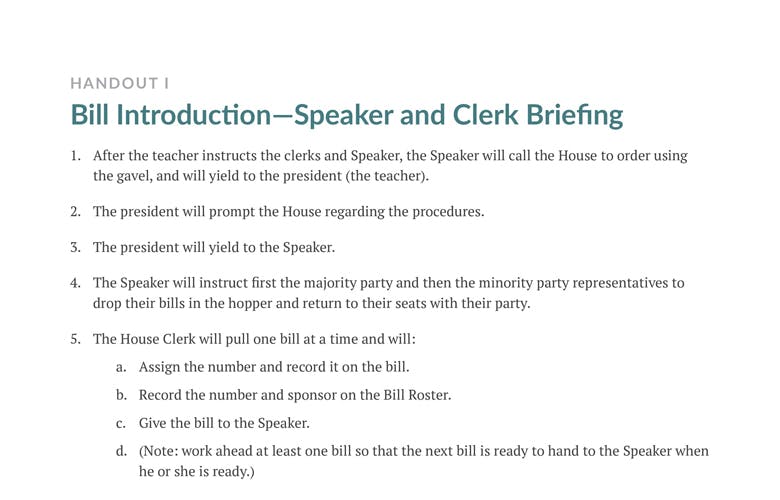Handout I: Bill Introduction – Speaker and Clerk Briefing
- After the teacher instructs the clerks and Speaker, the Speaker will call the House to order using the gavel, and will yield to the president (the teacher).
- The president will prompt the House regarding the procedures.
- The president will yield to the Speaker.
- The Speaker will instruct first the majority party and then the minority party representatives to drop their bills in the hopper and return to their seats with their party.
- The House Clerk will pull one bill at a time and will:
- Assign the number and record it on the bill.
- Record the number and sponsor on the Bill Roster.
- Give the bill to the Speaker.
- (Note: work ahead at least one bill so that the next bill is ready to hand to the Speaker when he or she is ready.)
- Party Clerk will make notes regarding issues affecting the party platform.
- Speaker will announce the bill number, sponsor, and short title of the bill.
- Speaker will ask the bill sponsor to come forward and give the House a brief (less than one minute) summary of the bill. No questions will be permitted at this time. Party leaders will time the members and call time at one minute.
- Speaker will assign the bill to a committee and will announce, “Representative ____________________, I am assigning your bill to the _______________________ Committee.”
- Each committee needs to have an equal (or almost equal) number of bills. Keep track of the number of bills assigned on the Assignment of Bills to Committees form.
- Committee Clerk will record the bill information on the Committee Calendar, and the House Clerk will record the bill information on the Bill Roster.
- Speaker will ask, “Who would like to testify against this bill?”
- The witnesses will state their names.
- Those who volunteer as witnesses must do additional research to make their argument and answer questions during the committee hearing. They may choose whether they are an expert witness or part of a lobbying group against the bill.
(Note: The Speaker and House Clerk should volunteer to testify on one to three bills.)
- Speaker will ask, “Who would like to testify for this bill?”
- The witnesses will state their names.
- Those who volunteer as witnesses must do additional research to make their argument and answer questions during the committee hearing. They may choose whether they are an expert witness or part of a lobbying group for the bill.
(Note: The Speaker and House Clerk should volunteer to testify on one to three bills.)
- Committee Clerk will record the names of the witnesses on the Committee Calendar. There will be three witnesses for each bill, including the sponsor. Each bill must have at least one witness opposed to the bill.
- House Clerk gives the Speaker the next bill and the process repeats starting with step seven.
